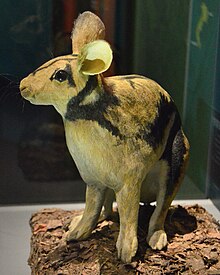Nesolagus
This articleneeds additional citations forverification.(February 2013) |
| Nesolagus | |
|---|---|

| |
| Sumatran striped rabbit | |
| Scientific classification | |
| Domain: | Eukaryota |
| Kingdom: | Animalia |
| Phylum: | Chordata |
| Class: | Mammalia |
| Order: | Lagomorpha |
| Family: | Leporidae |
| Genus: | Nesolagus Forsyth Major,1899 |
| Type species | |
| Lepus netscheri | |
| Species | |

| |
Nesolagusis agenusofrabbits[1]containing three species ofstriped rabbit:theAnnamite striped rabbit,theSumatran striped rabbit,and the extinct speciesN. sinensis.Overall there is very little known about the genus as a whole, most information coming from the Sumatran rabbit.
Species
[edit]The genusNesolagusincludes three species, one extinct:
- Sumatran striped rabbit,Nesolagus netscheri
- Annamite striped rabbit,Nesolagus timminsi
- †Nesolagus sinensis,[2]early Pleistocene of China.
Behavior
[edit]Due to the small number of individuals, and because of the rare sightings of this genus, there is not much information available on its behavior. One thing that we do know however, is that the Sumatran rabbit is nocturnal and hides out in burrows which it does not make itself and does not really like to go out looking for food for itself in places that are too far from its home.[3]
Description
[edit]Descriptions of the species are partly based on images made bycamera traps;for the Sumatran striped rabbit the cameras were set in the montane forests of Sumatra, while the Annamite Striped rabbit was seen in the Annamite mountain range of Laos and Vietnam.[4]Both species of striped rabbit have seven brown or black stripes and a red rump and white underside. They are the only species of rabbits to have stripes. They are relatively small with a length of about 368–417 mm, with a tail of about 17 mm and ears about 43–45 mm long. Thus the ears ofNesolagusare only about half as long as in most rabbits, e.g. in the genusLepus.Their fur is soft and dense, overlaid by longer, harsher hairs.[5]
Distribution
[edit]Striped rabbits are found in only four locations. The Sumatran striped rabbit has been found in theBarisan Mountainsin westernSumatra,Indonesia,and the Annamite striped rabbit has been found in theAnnamitemountains on the border betweenVietnamandLaos.[6]The fossils (parts of the left mandible with several teeth) of the extinctNesolagus sinensiswere found in Chongzou Ecological Park in the Guangnxi Zhuang region of southwest China.[7]
References
[edit]- ^Wilson, D. E.;Reeder, D. M., eds. (2005).Mammal Species of the World: A Taxonomic and Geographic Reference(3rd ed.).Johns Hopkins University Press.ISBN978-0-8018-8221-0.OCLC62265494.
- ^Jin, ChangZu; Yukimitsu Tomida; Yuan Wang; YingQi Zhang (1 August 2010). "First discovery of fossilNesolagus(Leporidae Lagomorpha) ".Science China Earth Sciences.53(8): 1134–1140.doi:10.1007/s11430-010-4010-3.S2CID88422971.
- ^"Animal Info - Endangered animals".Animal Info.Retrieved28 November2012.
- ^ed, Allan F. O'Connell... (2010-09-30).Camera traps in animal ecology: methods and analyses / Allan F. O'Connell, James D. Nichols, K. Ullas Karanth, editors.Tokyo: Springer.ISBN978-4-431-99494-7.
- ^Nowak, Ronald M. (1999).Walker's Mammals of the World(Sixth ed.). Baltimore, Maryland: Johns Hopkinds University Press. p. 1723.ISBN9780801857898.Retrieved15 November2012.
- ^Can; et al. (2001)."Annamite striped rabbitNesolagus timminsiin Vietnam "(PDF).Acta Theriologica.46(4): 437–440.doi:10.4098/at.arch.01-48.
- ^Jin; et al. (2009). "First discovery of fossilNesolagus(Leporidae, Lagomorpha) from Southeast Asia ".Science China Earth Sciences.53(8): 1134–1140.doi:10.1007/s11430-010-4010-3.S2CID88422971.


